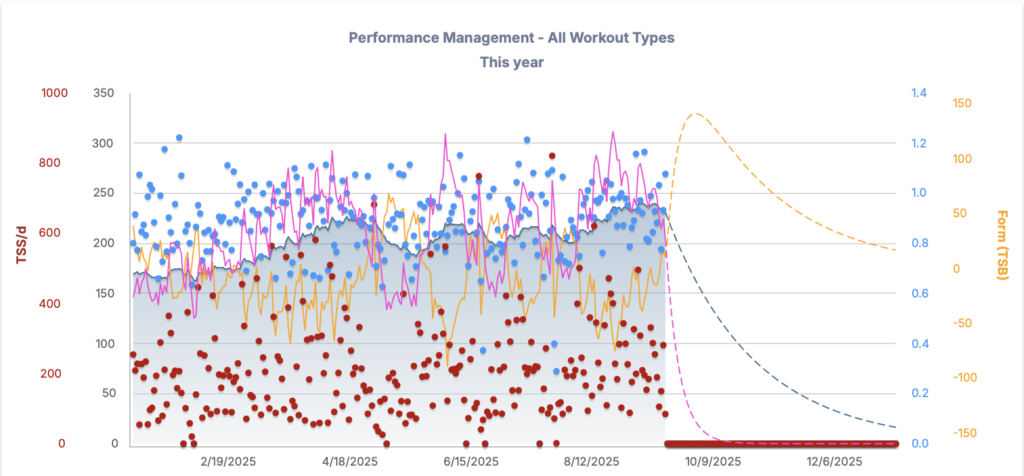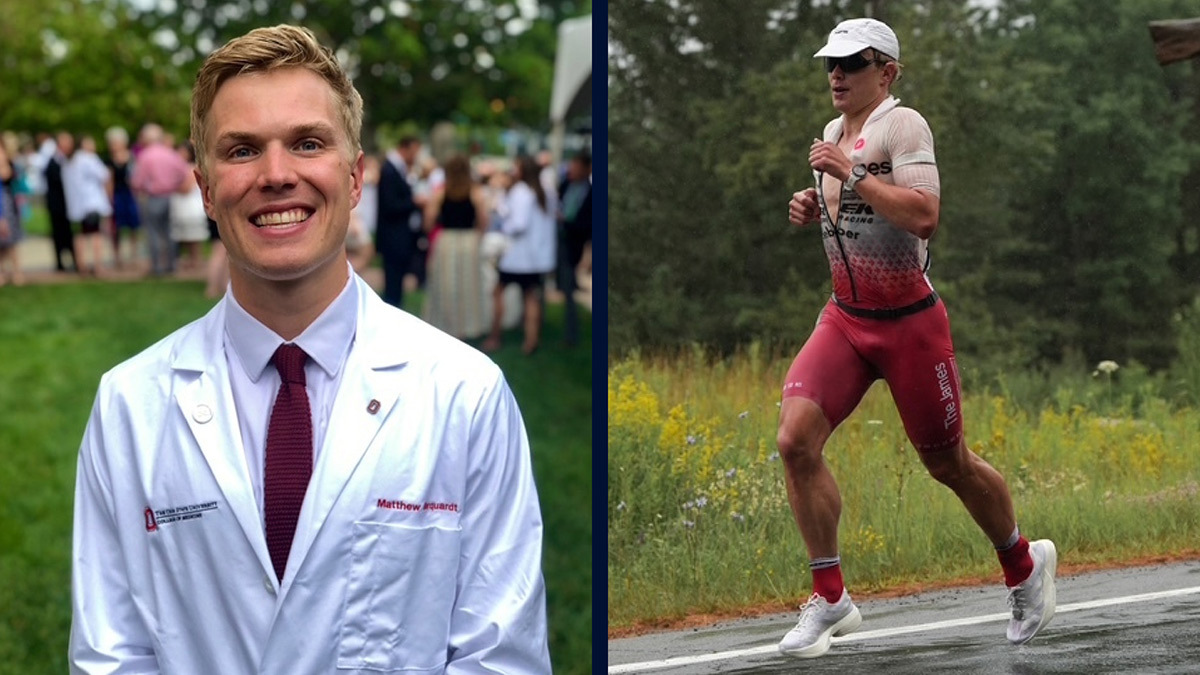人体一级高清图片搜索
Matthew Marquardt enters the 2025 Men’s Ironman World Championships ranked second in total points in the Ironman Pro Series, but his daily routine looks quite different from other elite triathletes in the standings.
A third-year medical student studying cancer research at Ohio State University, a typical day for Marquardt starts by 5 a.m. He makes lunch for his fiance, tackles some chores around the house, gets some school work done and then logs a morning training session — all before his classes and labs start at 9 a.m.
Then it’s more emails, writing and research, followed by another workout. Finally, dinner, some brief but cherished quality time with his fiance after she gets home from working the nightshift at the local hospital, and off to bed by 8 p.m.
Unlike some of his peers, Marquardt doesn’t train full-time, because he can’t. He has competing priorities of being one of the best triathletes in the world and making a positive impact in the world by integrating his experiences in triathlon with cancer research.
His secret? Structure.
“Matthew thrives with structure,” said Andrew Yoder, Marquardt’s coach and owner of Yoder Performance. “If he doesn’t have structure in his day, it can be a bit disorganized. He’s not someone who can just train full-time. He needs to have other interests and other focus points. And he thrives really well with that. And I found that when he is in classes, when he has a high workload, outside of training, he performs better.”
And it’s working. Marquardt heads into the Ironman World Championships in Nice, France, with back-to-back wins at Cairns and Lake Placid, finishing each in 7 hours, 50 minutes.
A Look Into Marquardt’s Weekly Volume
Professional triathletes train anywhere between 20 and 35 hours per week, on average. Marquardt is at the lower end of that range due to his studies and busy schedule.
He logs 20-25 hours consistently in weekly volume, and increases to 25-30 hours per week during race builds for Ironman distances, with a majority coming from long bike and run sessions, according to Yoder.
A typical training week for Marquardt consists of:
- 4 swims per week, with 4-5km per session and three quality sets
- 5 bike sessions per week
- 6 runs per week
Facing Adversity and Bouncing Back
Yoder started coaching Marquardt as an amateur in 2021, around the time he graduated magna cum laude from Princeton University, where he was a Division I swimmer. He immediately left his mark, finishing second at both the 70.3 Gulf Coast and 70.3 World Championship. He followed that with four straight wins at Ironman Texas, 70.3 Eagleman, Lake Placid and the Ironman World Championship Thursday race in Kona, Hawaii in October 2022.
Marquardt turned pro in 2023, during his second year of medical school. He finished third in his pro debut at Ironman Texas that year.
“He had a relatively smooth start to his professional career,” Yoder said. “Before Ironman 70.3 Worlds in New Zealand (2024) and really Kona in 2024, he had been on every domestic podium. He was relevant and had a lot of success. It wasn’t perfect, and there were things that we were working through then and continue to work through now, but he hadn’t really been pushed into a corner.”
That all changed when Marquardt had a string of tough races — from the 70.3 World Championship in 2024 where he finished 35th to the 70.3 St. George North American Championship in May 2025, where he placed 15th.
Yoder credits early race muscle spasms as the main issue. But the setback helped prepare Marquardt for wins at Cairns in June and Lake Placid in July leading up to another World Championship in Nice, where he finished 11th in 2023.
Because of Marquardt’s strength in the swim and bike, he typically is able to race forward, but the spasms allowed him to race a little bit from behind, and gain a new perspective. It took a lot of pressure off of him, and with the expectations off the table, he was able to just race.
Enter Cairns, where he found himself in unfamiliar territory — eight to 10 minutes behind the leader with an opportunity to work his way forward. Slowly. Methodically.
“What I’ve seen with Matthew, is sometimes when he forces it, that’s when we can get into trouble,” said Yoder, who has been coaching Marquardt since the beginning of his career. “And when he lets things play out, he races really well.”
A Not So ‘Nice’ Time in France
Yoder calls Marquardt’s 2023 Ironman Worlds experience in Nice a “major wakeup call.”
It was a new experience from a fueling, aerodynamics, tactics and overall approach to the race standpoint in Marquardt’s young career. His swim, as usual, was solid, but he struggled on the bike, riding 4:49:11.
“We went in there thinking that he would have a good opportunity to do really well. But looking further into the race, he really had difficulty with the riding, and not so much the technical components of the riding, but more so the durability of the riding,” Yoder said, noting that Marquardt lives in Columbus, Ohio, and does most of his riding on an indoor trainer in ERG mode.
But Marquardt battled, running a 2:43:44 to finish 11th overall.
“He was in a pretty tough spot off the bike, so it showed a bit of his character with how he managed to finish so well,” Yoder said.
Race Readiness and Power Control Variability
Yoder primarily uses first lactate threshold (LT1) and second lactate threshold (LT2) when monitoring and analyzing Marquardt’s training, with heart rate, pace and power in support.
“With the way that the training is set up, and how we have a consistent layering approach within the program, we have an understanding of where the lactate, the power, the heart rate — they all are very consistent over time. Like the power will shift obviously with progression, the pace will shift with the progression, but the lactate obviously is stable and we’ve seen heart rate over time be stable specifically to Matthew,” Yoder said.
Yoder prescribes Marquardt’s training in TrainingPeaks, an app that enables coaches and athletes to plan, track, and analyze training.
“What I’ve found really effective with TrainingPeaks is the race data,” Yoder said. “Having the race files, understanding the dynamic of how the race played out and what that looks like from the file. That helps us craft a bit or tinker the program slightly moving forward to prepare for what we would expect in a race.”
Yoder utilizes Training Stress Balance (TSB), otherwise known as Form in the TrainingPeaks Performance Management Chart, to analyze Marquardt’s readiness for a race.

“There’s obviously a lot of factors, but we can, in some ways, predict that he’s in really good Form based off the training, based off the metrics within it,” he said.
Another metric Yoder leverages is Variability Index (VI), a metric that shows you how steadily paced (or variable) a workout was ridden. Yoder not only uses VI with Marquardt, but finds it particularly useful with his age group triathletes.
“I found that a lot of age group athletes have difficulty with power control as far as variability,” he said. “So I use that as a heavy metric for athletes. And it seems if someone’s not really paying attention or doesn’t have the skills to control a tight power window, it can be a significant improvement in their performance.”
Marquardt is very good at control and keeping a really tight power window, but Yoder says that’s taken time and awareness of what he’s doing within the workouts.
Mechanical Durability a Focus of Marquardt’s Training
Since Marquardt lives in a relatively flat area of the U.S., Yoder incorporates gravel riding into his training to create durability.
“He will go out and he’ll do long durability gravel sessions, but he holds a super tight power window,” Yoder said. “And that is what allows us to say, okay, we’re getting the mechanical durability, but we’re also making sure we’re in the right metabolic spot.”
While Marquardt does very little strength training, he does daily mobility and core stability work, mostly to address the lower back and hip areas to prevent potential spasm issues during races.
According to Yoder, Marquardt responds really well to torque work. With a cadence of 50 RPM, he will do his LT2 intervals at torque. He’ll do durability sessions on the bike outside, creating a level of fatigue resistance.
And then with running, Marquardt does a lot of inclined treadmill work, which Yoder finds to be very productive, because they can pinpoint the intensity exactly.
“We’re really trying to get a lot of FTA activation and create a level of durability over time,” Yoder said. “And what’s really interesting is once we start to create — we start to replicate those types of sessions — you can see he improves week after week. The first week would be really difficult. He almost struggles. He’s so metabolically efficient, but mechanically fails at first. So it’s quite interesting. And this is something I’ve seen in other athletes.”
Takeaway for Age Groupers: Embrace Balance
Yoder not only coaches Marquardt, but also pro women’s triathlete Rachel Zilinskas, who finished fourth at both Lake Placid and 70.3 Indian Wells La Quinta last year. He also coaches a host of age group athletes dealing with their own version of stressors and chaotic life schedules.
“I’ve been coaching [Zilinskas] for eight years, and she’s continuing to get better,” Yoder said. “And so I think the big thing that I would communicate to age-group athletes is having the patience to sit yourself in the process. There’s no shortcut. Try not to overextend yourself within your training at any given point that can lead to burnout both athletically and then personally.”
Yoder adjusts his communication style depending on the athlete and the situation, but his attention to every athlete — whether it’s Marquardt or an age grouper training for their first 70.3 — remains the same. He’s had age-group athletes be successful at 10 hours, 15 hours and 20 hours of training per week. It all comes down to a personalized approach.
“What I love about coaching is that, regardless of level, the athletes care the same amount. So I approach every athlete the same as I would approach Matthew. And the communication is the same because you have to be all in,” Yoder said. “As a coach, if you can understand the athlete and what is stressful for the athlete, and what you can do on your end to help create optimal training load, then to me, that’s good coaching.”










